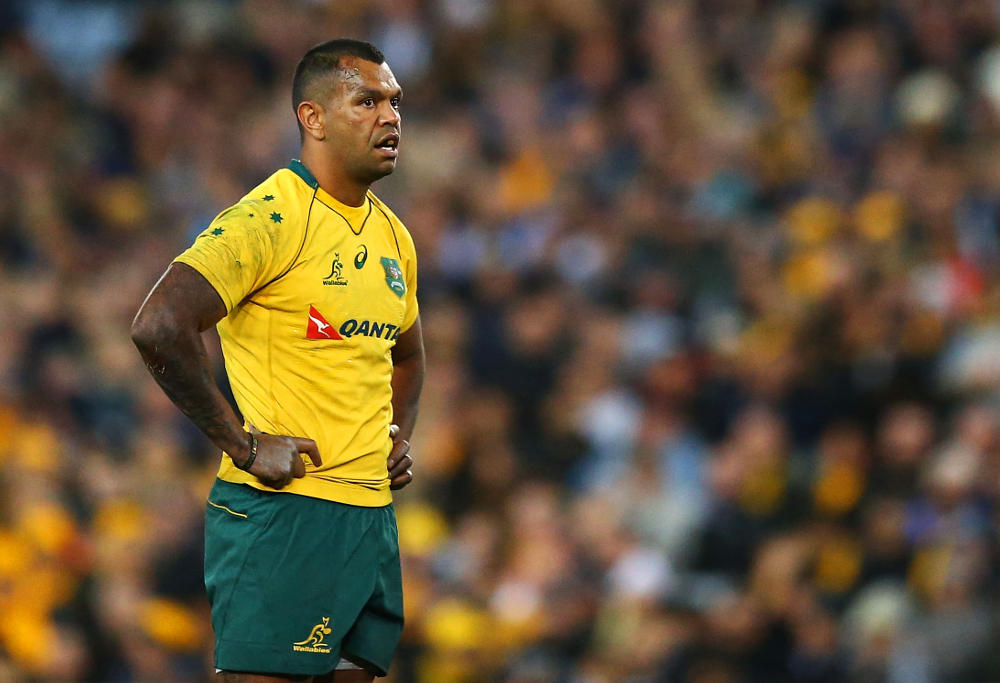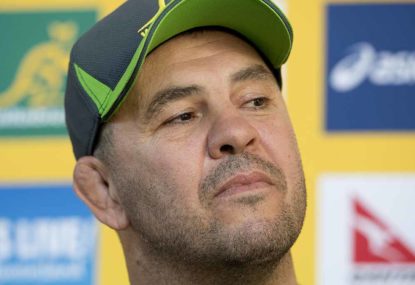“One hundred per cent, mate,” came the direct response from Wallabies coach Michael Cheika.
“One hundred per cent,” he repeated, for dramatic emphasis of what would become the immediate soundbite, simultaneously setting the tone for the build-up ahead of this weekend’s second Bledisloe Cup Test Match.
It was a very deliberate answer, pointedly delivered eyeball-to-eyeball straight back from where the very deliberate and equally pointed question came in the opening moments of the press conference on Saturday night.
After the Wallabies missed 37 first-half tackles to trail 40-6 at halftime, sending the press corps and broadcasters alike scurrying for the record books, Cheika was always going to be asked if he continued to have full faith in the defensive systems implemented by his defence coach, Nathan Grey.
And Cheika knew it was coming, clearly, because there was no pause before the answer. He couldn’t be seen to have any doubts, even if he did. So, he tried to jump straight on it, not giving it any chance to get away from him.
“One hundred per cent, mate. One hundred per cent.”
[latest_videos_strip category=”rugby” name=”Rugby”]
Sure enough though, Sunday’s headlines told the tale of woe.
“Wallabies stunned by All Blacks in bizarre Bledisloe opener”, Fairfax ran with. “Cheika defends the indefensible”, the Daily Telegraph in Sydney followed, while for the Courier Mail in Brisbane, former Wallabies skipper Andrew Slack opined with scything accuracy, “Somehow, the Wallabies debacle was worse than it looked.”
The test for Cheika, and especially Grey now, is how to address the many defensive issues.
The Wallabies introduced a new structure for this Test, so they said post-match, which still looked remarkably similar to the same players in motion, swing-your-partner-round-and-round, overly complicated musical chairs structure that’s been causing defensive issues for 18 months now.
Whether it looked any different to the New Zealand attackers is immaterial, because they did the same thing they’ve always done: eyed off the likely chink in the alignment, and run at it.
When you look at Australia’s missed and ineffective tackle numbers, the one thing the stands out is that the bulk came from the three-quarter line of Curtis Rona, Kurtley Beale, Samu Kerevi, and Henry Speight. There were 17 missed tackles between the four of them, according to the official SANZAAR numbers.
In the case of Rona and Speight, most of the ten they missed collectively came in midfield, where the two wingers defended in the centre channels. Now, Rona has defended at 13 for most of the season for the Western Force, but never at 12 or 13 having come in from the wing. Likewise, winger Speight doesn’t defend in the centres for the Brumbies for very good reason.
A combination of two guys defending in unfamiliar territory and circumstances, a lack of communication, and no real evident trust in the inside defenders meant defenders were pushing in too far, or worse, not far enough all night.
Slack summed this up perfectly: “Time together is crucial and with debutant Curtis Rona given some midfield defensive responsibilities, the All Blacks smelled blood in that area and drank it like a thirsty vampire.”

Photo by Mark Nolan/Getty Images
Similarly, for Beale and Kerevi, many of their seven combined misses came when acting as the designated shooter in defence, where the idea is to pressure the ball-carrier and make the tackle – or at least slow the opposition player down – well behind the gain line. But again, a combination of poor initial-contact and the slide defence not reacting quickly enough in behind created way too many gaps for the All Blacks to create second-phase opportunities.
Beauden Barrett worked this out quickly; if he just took the initial shooting contact, or looped around another crash runner into said shooting defender, the lack of cover in behind was where the space was.
Too many moving parts, not enough trust, and lazy cover in behind the shooting defenders are the three major failings of the Wallabies’ current defensive system. And if that’s not attitude of the individuals, like Cheika suggested post-match, then it must be a failing in the system itself.
Grey knows he’s under pressure, but worryingly doubled down on his strategy.
“As a defensive coach, it’s difficult. But that’s the great thing about the game. You get to look at things you did wrong and how you can improve. You lick your wounds, pull yourself together and get stuck in again,” Grey said, as the Wallabies set up base in Christchurch on Monday.
“We had a good look at it and really believe the way we’re trying to do things … is going to be really positive for us and when we get that right and everyone executes we can get the results we’re looking for.”
Their staunchest defence at the moment does indeed appear to be when defending the clearly indefensible.
If the crucial step of beating addiction is admitting to the problem in the first place, then the Wallabies appear to be a concerning distance from the rehab clinic just yet.






























































































